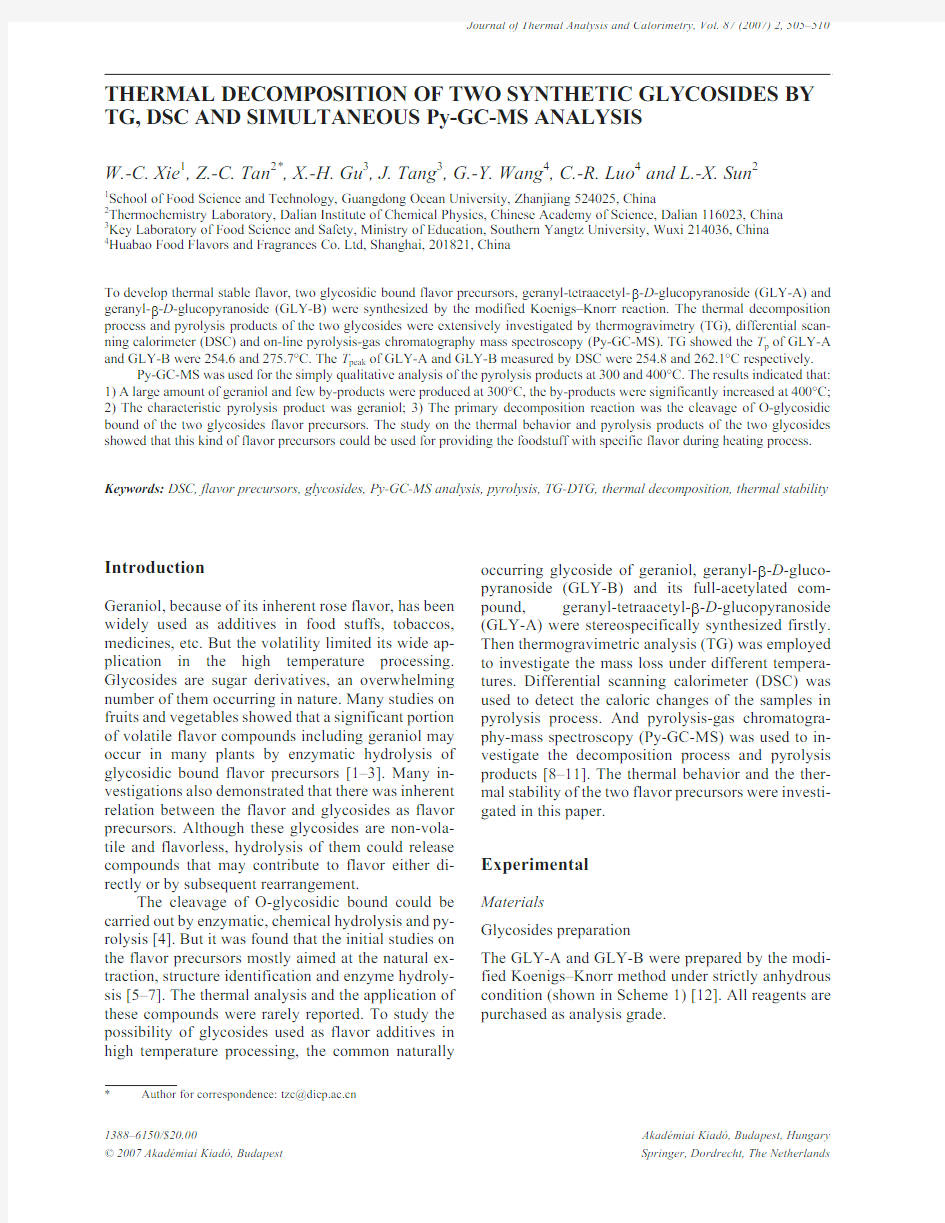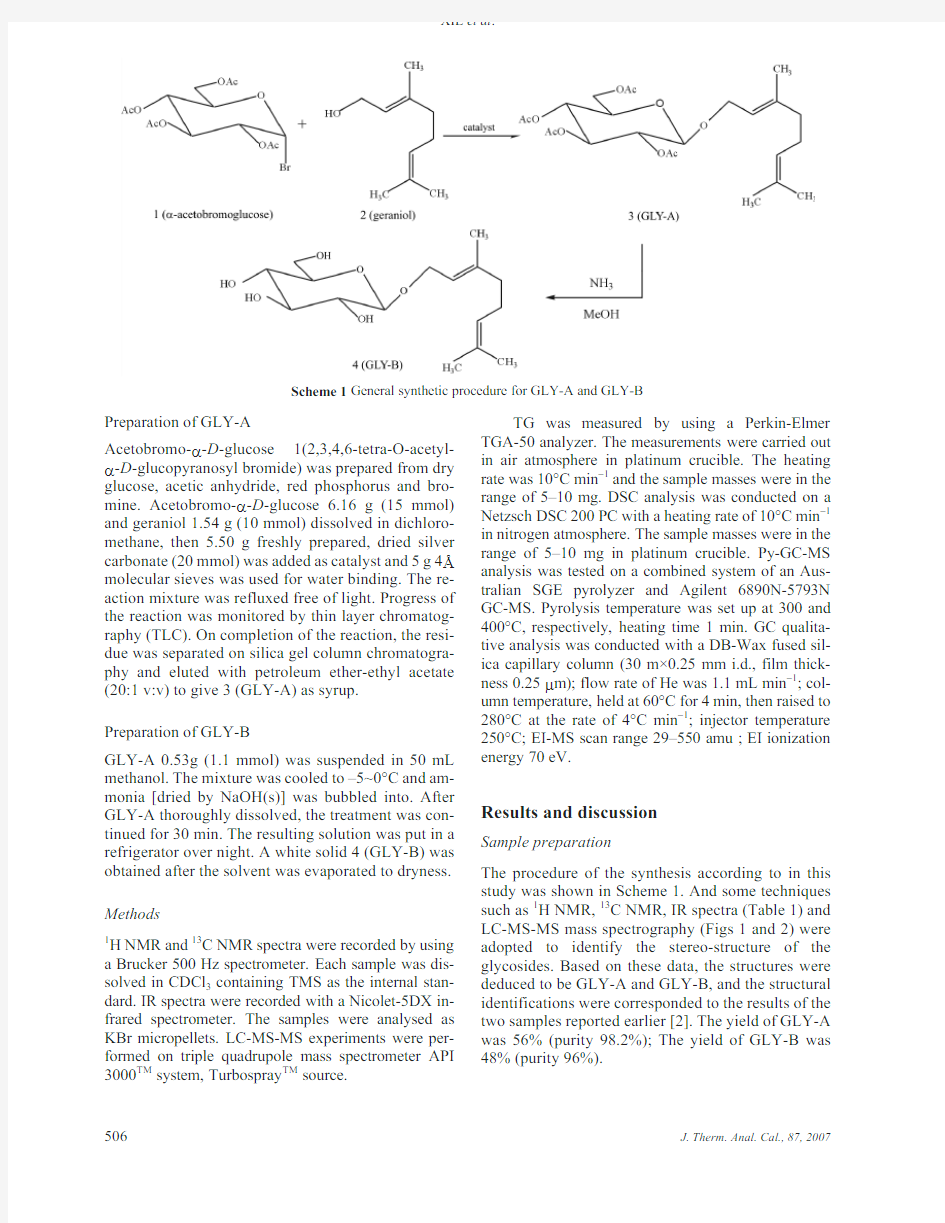香叶醇糖苷裂解


Introduction
Geraniol,because of its inherent rose flavor,has been widely used as additives in food stuffs,tobaccos, medicines,etc.But the volatility limited its wide ap-plication in the high temperature processing. Glycosides are sugar derivatives,an overwhelming number of them occurring in nature.Many studies on fruits and vegetables showed that a significant portion of volatile flavor compounds including geraniol may occur in many plants by enzymatic hydrolysis of glycosidic bound flavor precursors[1–3].Many in-vestigations also demonstrated that there was inherent relation between the flavor and glycosides as flavor precursors.Although these glycosides are non-vola-tile and flavorless,hydrolysis of them could release compounds that may contribute to flavor either di-rectly or by subsequent rearrangement.
The cleavage of O-glycosidic bound could be carried out by enzymatic,chemical hydrolysis and py-rolysis[4].But it was found that the initial studies on the flavor precursors mostly aimed at the natural ex-traction,structure identification and enzyme hydroly-sis[5–7].The thermal analysis and the application of these compounds were rarely reported.To study the possibility of glycosides used as flavor additives in high temperature processing,the common naturally
occurring glycoside of geraniol,geranyl-b-D-gluco-pyranoside(GLY-B)and its full-acetylated com-pound,geranyl-tetraacetyl-b-D-glucopyranoside (GLY-A)were stereospecifically synthesized firstly. Then thermogravimetric analysis(TG)was employed to investigate the mass loss under different tempera-tures.Differential scanning calorimeter(DSC)was used to detect the caloric changes of the samples in pyrolysis process.And pyrolysis-gas chromatogra-phy-mass spectroscopy(Py-GC-MS)was used to in-vestigate the decomposition process and pyrolysis products[8–11].The thermal behavior and the ther-mal stability of the two flavor precursors were investi-gated in this paper.
Experimental
Materials
Glycosides preparation
The GLY-A and GLY-B were prepared by the modi-fied Koenigs–Knorr method under strictly anhydrous condition(shown in Scheme1)[12].All reagents are purchased as analysis grade.
Journal of Thermal Analysis and Calorimetry,Vol.87(2007)2,505–510
THERMAL DECOMPOSITION OF TWO SYNTHETIC GLYCOSIDES BY TG,DSC AND SIMULTANEOUS Py-GC-MS ANALYSIS
W.-C.Xie1,Z.-C.Tan2*,X.-H.Gu3,J.Tang3,G.-Y.Wang4,C.-R.Luo4and L.-X.Sun2
1School of Food Science and Technology,Guangdong Ocean University,Zhanjiang524025,China
2Thermochemistry Laboratory,Dalian Institute of Chemical Physics,Chinese Academy of Science,Dalian116023,China
3Key Laboratory of Food Science and Safety,Ministry of Education,Southern Yangtz University,Wuxi214036,China
4Huabao Food Flavors and Fragrances Co.Ltd,Shanghai,201821,China
To develop thermal stable flavor,two glycosidic bound flavor precursors,geranyl-tetraacetyl-b-D-glucopyranoside(GLY-A)and geranyl-b-D-glucopyranoside(GLY-B)were synthesized by the modified Koenigs–Knorr reaction.The thermal decomposition process and pyrolysis products of the two glycosides were extensively investigated by thermogravimetry(TG),differential scan-ning calorimeter(DSC)and on-line pyrolysis-gas chromatography mass spectroscopy(Py-GC-MS).TG showed the T p of GLY-A and GLY-B were254.6and275.7°C.The T peak of GLY-A and GLY-B measured by DSC were254.8and262.1°C respectively.
Py-GC-MS was used for the simply qualitative analysis of the pyrolysis products at300and400°C.The results indicated that:
1)A large amount of geraniol and few by-products were produced at300°C,the by-products were significantly increased at400°C;
2)The characteristic pyrolysis product was geraniol;3)The primary decomposition reaction was the cleavage of O-glycosidic bound of the two glycosides flavor precursors.The study on the thermal behavior and pyrolysis products of the two glycosides showed that this kind of flavor precursors could be used for providing the foodstuff with specific flavor during heating process.
Keywords:DSC,flavor precursors,glycosides,Py-GC-MS analysis,pyrolysis,TG-DTG,thermal decomposition,thermal stability *Author for correspondence:tzc@https://www.360docs.net/doc/7011097838.html,
Preparation of GLY-A
Acetobromo-a-D-glucose1(2,3,4,6-tetra-O-acetyl-a-D-glucopyranosyl bromide)was prepared from dry glucose,acetic anhydride,red phosphorus and bro-mine.Acetobromo-a-D-glucose6.16g(15mmol) and geraniol1.54g(10mmol)dissolved in dichloro-methane,then5.50g freshly prepared,dried silver carbonate(20mmol)was added as catalyst and5g4 molecular sieves was used for water binding.The re-action mixture was refluxed free of light.Progress of the reaction was monitored by thin layer chromatog-raphy(TLC).On completion of the reaction,the resi-due was separated on silica gel column chromatogra-phy and eluted with petroleum ether-ethyl acetate (20:1v:v)to give3(GLY-A)as syrup.
Preparation of GLY-B
GLY-A0.53g(1.1mmol)was suspended in50mL methanol.The mixture was cooled to–5~0°C and am-monia[dried by NaOH(s)]was bubbled into.After GLY-A thoroughly dissolved,the treatment was con-tinued for30min.The resulting solution was put in a refrigerator over night.A white solid4(GLY-B)was obtained after the solvent was evaporated to dryness.
Methods
1H NMR and13C NMR spectra were recorded by using a Brucker500Hz spectrometer.Each sample was dis-solved in CDCl3containing TMS as the internal stan-dard.IR spectra were recorded with a Nicolet-5DX in-frared spectrometer.The samples were analysed as KBr micropellets.LC-MS-MS experiments were per-formed on triple quadrupole mass spectrometer API 3000TM system,Turbospray TM source.
TG was measured by using a Perkin-Elmer TGA-50analyzer.The measurements were carried out in air atmosphere in platinum crucible.The heating rate was10°C min–1and the sample masses were in the range of5–10mg.DSC analysis was conducted on a Netzsch DSC200PC with a heating rate of10°C min–1 in nitrogen atmosphere.The sample masses were in the range of5–10mg in platinum crucible.Py-GC-MS analysis was tested on a combined system of an Aus-tralian SGE pyrolyzer and Agilent6890N-5793N GC-MS.Pyrolysis temperature was set up at300and 400°C,respectively,heating time1min.GC qualita-tive analysis was conducted with a DB-Wax fused sil-ica capillary column(30m×0.25mm i.d.,film thick-ness0.25m m);flow rate of He was1.1mL min–1;col-umn temperature,held at60°C for4min,then raised to 280°C at the rate of4°C min–1;injector temperature 250°C;EI-MS scan range29–550amu;EI ionization energy70eV.
Results and discussion
Sample preparation
The procedure of the synthesis according to in this study was shown in Scheme1.And some techniques such as1H NMR,13C NMR,IR spectra(Table1)and LC-MS-MS mass spectrography(Figs1and2)were adopted to identify the stereo-structure of the glycosides.Based on these data,the structures were deduced to be GLY-A and GLY-B,and the structural identifications were corresponded to the results of the two samples reported earlier[2].The yield of GLY-A was56%(purity98.2%);The yield of GLY-B was 48%(purity96%).
XIE et al
.
Scheme1General synthetic procedure for GLY-A and GLY-B
THERMAL DECOMPOSITION OF TWO SYNTHETIC GLYCOSIDES
Table 1NMR and IR analysis of the synthesized GLY-A and GLY-B
Compound
1
H NMR d (in CDCl 3
)
13
C NMR d (in
CDCl 3)
IR/cm –1
KBr micropollets GLY-A
1.60–1.67(9H,8,9,10-CH 3)1.73–
2.03(12H,4CH 3)
16.39–26.28(7C,CH 3)39.46(Ger,C-5),
2927,1747C 24H 36O 10
2.09(4H,2CH 2),
3.94(1H,Glu-5’CH)39.51(Ger,C-4),60.54(Ger,C-1)1668(W),1225MW :484
4.03(2H,Glu-6’CH),4.19(2H,CH 2)
4.32(1H,Glu-4’CH),4.90(1H,Glu-3’CH 2)
5.07(1H,=CH),5.19(1H,Glu-2’CH)5.27(1H,=CH),5.70(1H,Glu-1’CH)
63.09(Glu-6’C),66.96(Glu-5’C)68.27(Glu-4’C),70.18(Glu-3’C)73.10(Glu-2’C),96.93(Glu-1’C)119.91(Ger,C-6),123.66(Ger,C-2)131.67(Ger,C-3),140.31(Ger,C-7)169.12–170.66(Glu,4CO)1040,923
GLY-B 1.60(3H,10-CH 3),1.69(6H,8,9-CH 3)16.33(Ger,C-10),17.63(Ger,C-9)3392,2924C 16H 28O 6
2.05(4H,4,5-CH 2)
3.26–3.60(4H,m,Glu-2’-4’)
25.62(Ger,C-8)26.40(Ger,C-5)
1653(w)MW :316
3.84(2H,Glu-6’)
4.20(1H,J =7.0Hz,Glu-1’)4.33(2H,1-CH 2)
5.41(1H,6-C=CH),5.43(1H,2-C=CH)
39.61(Ger,C-4),61.29(Ger,C-1)61.34(Glu,C-6’),65.86(Glu,C-5’)69.37(Glu,C-4’),73.28(Glu,C-3’)75.65(Glu,C-2’),101.46(Glu,C-1’)119.77(Ger,C-2),123.83(Ger,C-6)131.63(Ger,C-7),141.28(Ger,C-3)
907
Fig.1LC-MS-MS spectrogram of GLY-A
Fig.2LC-MS-MS spectrogram of GLY-B
Fig.3TG-DTG curve of GLY-A
Fig.4TG-DTG curve of GLY-B
Pyrolysis behavior of GLY-A and GLY-B
Figures3and4showed both TG and DTG curves were recorded for GLY-A and GLY-B vs.tempera-ture from room temperature to400°C.The curves in-dicated the relationship between temperature change and mass loss of the samples.It revealed that the py-rolysis process of GLY-A had a main decomposition stage in the temperature range of200–300°C.In this stage,the mass loss was very fast and significant with the largest mass loss rate of11.56%min–1at the T p of 254.6°C.The total mass loss was96.91%.It was ob-served that pyrolysis process of GLY-B included three stages of loss mass.The initial stage was caused by ethyl acetate used in sample preparation;the sec-ond stage was caused by the by-product,acetamide,which was confirmed by Py-GC-MS.The mass loss was very low during first two stages.The third stage was the main one attributed to the total degradation of the GLY-B from230–310°C.The largest mass loss rate of11.75%min–1appeared at T p of275.7°C.The total mass loss was94.70%.
The DSC curves of the samples were shown in Figs5and6.It presented the thermograph of the sam-ples vs.the temperature.The measurements of the on-set temperature of thermal decomposition allowed us to determine the thermal stability of samples from an-other point.T peak of GLY-A was254.8°C and T peak of GLY-B was262.1°C.It can be seen that there was a shoulder peak in the DSC curve of GLY-A between 170–200°C,which may be caused by the cleavage of acetyls from GLY-A.Because geraniol was released by the cleavage of O-glycosidic bound at254.8°C,the acetyls were cleaved from the glycoside easier than O-glycosidic bound according to the molecular struc-ture.Moreover there were four acetyls in GLY-A, which caused a broad peak as shown in the DSC curve of GLY-A.This conclusion should be con-firmed by further experiment.In general,the results detected by TG and DSC were consistent.The data concerning the decomposition temperature and the enthalpy change were summarized in Table2. Study of pyrolysis products of GLY-A and GLY-B
TG and DSC seemed to be important means to study thermal properties of organic compounds.As noted above in TG and DSC analysis,the thermal stability of the samples was satisfactory.However,the pyrolysis products were not identified.The researches on com-ponents of pyrolysis products were important for the application of the glycosides as additives in food man-ufacture.The simultaneous Py-GC-MS analysis was used with a special pyrolyser connected directly with a gas chromatograph.The decomposition products were identified by MS after separated by GC.The MS spec-trogram of geraniol was shown in Fig.7,and four main ions of other each pyrolysis product were offered.The TIC curves of GLY-A and GLY-B were shown in Figs8and9and the most important characteristic compounds were summarized in Tables3and4.
The identification of the pyrolysis products of GLY-A and GLY-B could be carried out by
XIE et al
.
Fig.5DSC curve of
GLY-A
Fig.6DSC curve of GLY-B
Table2The degradation process of GLY-A and GLY-B
Py-GC-MS.The pyrolysis temperatures chosen for them were 300and 400°C.Figure 8showed that pyroly-sis of GLY-A produced 76.63%geraniol at 300°C,but at 400°C produced 17.83%geraniol.Figure 9showed that pyrolysis of GLY-B produced 51.86%geraniol at
THERMAL DECOMPOSITION OF TWO SYNTHETIC GLYCOSIDES
Table 3Py-GC-MS result of GLY-A at different temperatures
a
The ion of highest abundance and molecular ion were bold;b The molecular ion was the highest abundance ion
Table 4Py-GC-MS result of GLY-B at different temperatures a
The ion of highest abundance and molecular ion were bold;b The molecular ion was the highest abundance ion
Fig.7MS spectrogram of geraniol
Fig.8Total ion chromatograms of GLY-A at different tem-peratures a –300,b –400°C
300°C,and at400°C produced35.59%geraniol. Among pyrolysis products,ethyl acetate was solvent residue and acetamide was by-product during sample preparation.Myrcene,beta citral,allo-ocimene, trans-ocimene etc.were derivates of geraniol.Others were glucose decomposition compounds or rearrange-ment compounds.The results indicated pyrolysis of glycosides at300°C was better than at400°C,because there was a significant amount of geraniol compound is produced,and fewer by-products.Geraniol was the main product and played a very important role in pro-ducing the specific flavor.So300°C was preferable an application temperature.The Py-GC-MS indicated that the flavor precursors release characteristic flavor during high temperature treatment.
Furthermore,the possibility of GLY-A and GLY-B used as flavor precursors was compared be-low.Firstly,pyrolysis of GLY-A and GLY-B pro-duced76.63%and51.86%geraniol at300°C respec-tively.Secondly,the yield of GLY-A was56%but GLY-B was48%,and GLY-A was obtained easier than GLY-B.According to these results,GLY-A has more advantages than GLY-B in application.Conclusions
The thermal behavior and the decomposition products of two glycosides were studied by TG,DSC and Py-GC-MS analysis.The main product of pyrolysis was geraniol,so it can be concluded that the thermo-lysis mechanism of these glycosides flavor precursors was the cleavage of O-glycosidic bound.The primary decomposition reaction was that the flavor precursors break down to regenerate the flavor and glucose on heating.Moreover,GLY-A has more advantages than GLY-B for using as flavor precursors. References
1L.Jiang,H.Kojima and K.Yamada,J.Agric.Food Chem., 49(2001)5888.
2P.J.Williams and R.Christopher,Phytochem.,
21(1982)2013.
3M.Yano,Y.Joki and H.Mutoh,Agric.Biol.Chem.,
55(1991)1205.
4S.Matsumura,S.Takahashi and N.Kitano,
J.Agric.Food Chem.,45(1997)2674.
5R.Boulanger and J.Crouzet,Food Chem.,74(2001)209. 6G.Krammer,P.Winterhalter and M.Schwab,
J.Agric.Food Chem.,39(1991)778.
7Y.Li,C.Jiang and X.Wan,Acta Biochim.Biophys.Sinica, 37(2005)363.
8P.Zhu,S.Sui and B.Wang,J.Anal.Appl.Pyrolysis,
71(2004)645.
9E.Lizarraga,C.Zabaleta and A.Juan,Thermochim.Acta, 427(2005)171.
10F.Xu,L.-X.Sun,Z.-C.Tan,J.-G.Liang,Y.-Y.Di, Q.-F.Tian and T.Zhang,J.Therm.Anal.Cal.,76(2004)481. 11N.Deyanka and P.Rumiana,J.Therm.Anal.Cal., 84(2006)401.
12J.Mastelio,I.Jerkovio,M.Vinkovio,Z.D?olio and
D. Vikio-Topio,Croat.Chem.Acta,77(2004)491. Received:April3,2006
Accepted:September5,2006
OnlineFirst:December18,2006
DOI:10.1007/s10973-006-7617-z
XIE et al
. Fig.9Total ion chromatograms of GLY-B at different tem-peratures a–300,b–400°C
